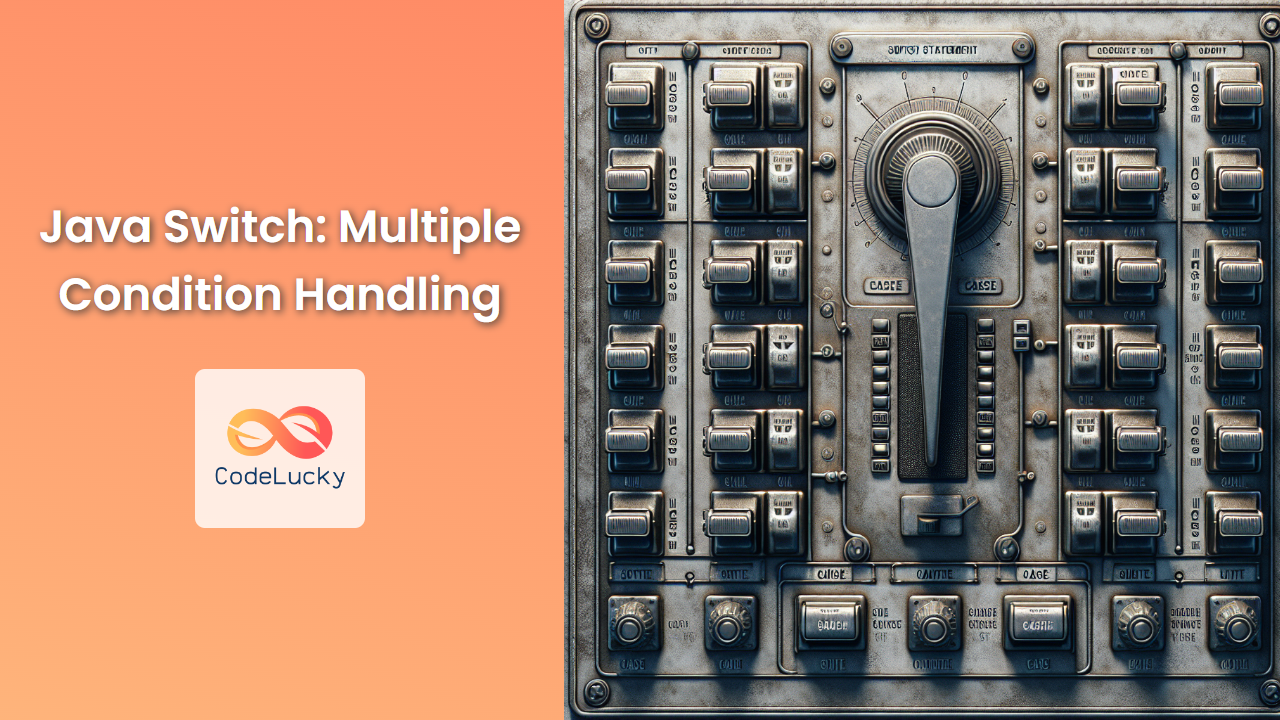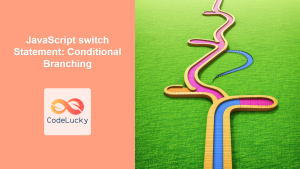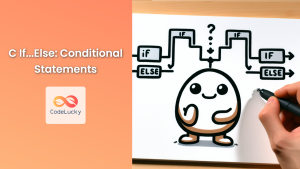Java's switch statement is a powerful control flow mechanism that allows developers to efficiently handle multiple conditions. It's an alternative to long chains of if-else statements, offering a more readable and often more performant solution for selecting among many possible execution paths. In this comprehensive guide, we'll dive deep into the Java switch statement, exploring its syntax, use cases, and best practices.
Understanding the Java Switch Statement
The switch statement in Java is designed to test a variable against multiple possible values. It's particularly useful when you have a single variable that you want to compare against a series of constants.
Here's the basic syntax of a switch statement:
switch (expression) {
case value1:
// code block
break;
case value2:
// code block
break;
...
default:
// code block
}
Let's break down each component:
expression: This is the variable or expression being tested.case value: These are the possible values that the expression might match.break: This keyword is used to exit the switch block after a match is found.default: This is an optional block that runs if no case matches the expression.
🚀 Simple Switch Example
Let's start with a basic example to illustrate how a switch statement works:
int dayNumber = 3;
String dayName;
switch (dayNumber) {
case 1:
dayName = "Monday";
break;
case 2:
dayName = "Tuesday";
break;
case 3:
dayName = "Wednesday";
break;
case 4:
dayName = "Thursday";
break;
case 5:
dayName = "Friday";
break;
case 6:
dayName = "Saturday";
break;
case 7:
dayName = "Sunday";
break;
default:
dayName = "Invalid day";
}
System.out.println("The day is: " + dayName);
Output:
The day is: Wednesday
In this example, we're using the switch statement to convert a day number into its corresponding name. The dayNumber variable is compared against each case, and when a match is found (case 3), the corresponding code block is executed.
🎭 Switch with Char
Switch statements in Java aren't limited to integers. They can also work with char values:
char grade = 'B';
String performance;
switch (grade) {
case 'A':
performance = "Excellent";
break;
case 'B':
performance = "Good";
break;
case 'C':
performance = "Average";
break;
case 'D':
performance = "Poor";
break;
case 'F':
performance = "Fail";
break;
default:
performance = "Invalid grade";
}
System.out.println("Student performance: " + performance);
Output:
Student performance: Good
🧵 Switch with String (Java 7+)
Since Java 7, switch statements can also work with String values:
String fruit = "apple";
String fruitType;
switch (fruit.toLowerCase()) {
case "apple":
case "pear":
fruitType = "Pome fruit";
break;
case "cherry":
case "plum":
fruitType = "Stone fruit";
break;
case "banana":
fruitType = "Tropical fruit";
break;
default:
fruitType = "Unknown fruit type";
}
System.out.println(fruit + " is a " + fruitType);
Output:
apple is a Pome fruit
Note how we've used fruit.toLowerCase() in the switch expression. This is a common practice to ensure case-insensitive matching.
🎭 Fall-through Behavior
One unique aspect of switch statements is their fall-through behavior. If you omit the break statement, execution will continue to the next case:
int number = 2;
String size;
switch (number) {
case 1:
size = "Small";
break;
case 2:
case 3:
size = "Medium";
break;
case 4:
case 5:
size = "Large";
break;
default:
size = "Unknown";
}
System.out.println("Size: " + size);
Output:
Size: Medium
In this example, both case 2 and case 3 will result in "Medium". This fall-through behavior can be useful, but it can also lead to bugs if break statements are accidentally omitted.
🚦 Switch Expressions (Java 12+)
Java 12 introduced switch expressions, which provide a more concise way to use switch statements:
int month = 8;
String season = switch (month) {
case 12, 1, 2 -> "Winter";
case 3, 4, 5 -> "Spring";
case 6, 7, 8 -> "Summer";
case 9, 10, 11 -> "Autumn";
default -> "Invalid month";
};
System.out.println("The season is: " + season);
Output:
The season is: Summer
This new syntax eliminates the need for break statements and allows multiple case labels for a single result.
🏗️ Complex Switch Example
Let's look at a more complex example that demonstrates how switch statements can be used in real-world scenarios:
enum HttpStatus {
OK, NOT_FOUND, INTERNAL_SERVER_ERROR, BAD_REQUEST
}
public class HttpResponseHandler {
public static String handleResponse(HttpStatus status) {
String response = switch (status) {
case OK -> {
System.out.println("Request successful");
yield "200 OK: Request processed successfully";
}
case NOT_FOUND -> {
System.out.println("Resource not found");
yield "404 Not Found: The requested resource could not be found";
}
case INTERNAL_SERVER_ERROR -> {
System.out.println("Server encountered an error");
yield "500 Internal Server Error: The server encountered an unexpected condition";
}
case BAD_REQUEST -> {
System.out.println("Invalid request received");
yield "400 Bad Request: The server cannot process the request due to client error";
}
default -> {
System.out.println("Unhandled status code");
yield "Unhandled HTTP status code";
}
};
return response;
}
public static void main(String[] args) {
System.out.println(handleResponse(HttpStatus.OK));
System.out.println(handleResponse(HttpStatus.NOT_FOUND));
}
}
Output:
Request successful
200 OK: Request processed successfully
Resource not found
404 Not Found: The requested resource could not be found
This example demonstrates how switch expressions can be used to handle different HTTP status codes. It uses the yield keyword to return a value from each case, and shows how multiple statements can be included in each case using code blocks.
🎯 Best Practices for Using Switch Statements
-
Use
defaultwisely: Always include adefaultcase unless you're absolutely sure you've covered all possible values. -
Be careful with fall-through: If you're using fall-through behavior intentionally, comment it to make your intentions clear.
-
Consider switch expressions: For Java 12 and later, switch expressions often lead to cleaner, more readable code.
-
Use enums with switch: Enums and switch statements work great together, providing type safety and completeness checking.
-
Keep it simple: If your switch statement is becoming too complex, consider refactoring to a different design pattern.
🎓 Conclusion
The Java switch statement is a versatile tool for handling multiple conditions. From its basic form to the more advanced switch expressions introduced in recent Java versions, it offers developers a clean and efficient way to write branching logic. By understanding its nuances and following best practices, you can write more readable and maintainable code.
Remember, while switch statements are powerful, they're not always the best solution. For complex conditional logic, consider other design patterns or control structures that might better suit your needs. As with all programming constructs, the key is to use switch statements judiciously to create code that is both efficient and easy to understand.
This comprehensive guide to Java's switch statement should provide readers with a thorough understanding of its usage, from basic concepts to advanced techniques. The examples cover a range of scenarios, demonstrating the versatility of switch statements in Java programming.

















